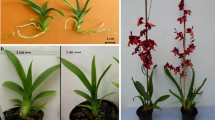Abstract
Prevention of flower formation is important, for example for preventing the spread of transgenes from genetically modified plants or the spread of non-native species, for increasing vegetative growth or preventing the formation of allergenic pollen. The aim of this study was to determine whether flowering of dicotyledonous plants can be prevented by genetic manipulation without harmful effects on vegetative growth. Here we describe isolation of the BpMADS1 gene (similar to SEP3, formerly AGL9) from birch and show that it is expressed only in the inflorescences. In tobacco and Arabidopsis, the expression of BpMADS1::GUS was also virtually inflorescence-specific. Transgenic tobacco and Arabidopsis containing a BpMADS1::BARNASE construct grew well. In one tobacco line the formation of the inflorescence was completely prevented; in several other lines the flowers lacked stamens and carpels and therefore were sterile. The final dry weights of the shoots of the sterile tobacco lines were 140–200% of those of controls. In Arabidopsis, some of the transgenic lines containing the BpMADS1::BARNASE construct formed inflorescences. Some of these lines formed never flowers and some others formed occasionally single fertile flowers. Some other lines did not form inflorescences, but formed up to about one hundred leaves, even in long-day conditions. These results suggest that formation of flowers or inflorescences in widely different dicotyledonous plants could be prevented using the BpMADS1::BARNASE construct and that prevention of flowering may lead to increased vegetative mass.
Similar content being viewed by others
References
Angenent G.C., Busscher M., Franken J., Mol J.N.M. and van Tunen A.J. 1992. Differential expression of two MADS box genes in wild-type and mutant petunia flowers. Plant Cell 4: 983–993.
Beals T.P. and Goldberg R.B. 1997. A novel cell ablation strategy blocks tobacco anther dehiscence. Plant Cell 9: 1527–1545.
Bechtold N., Ellis J. and Pelletier G. 1993. In planta Agrobacterium mediated gene transfer by infiltration of adult Arabidopsis thaliana plants. C.R. Acad. Sci. Paris, Sci. Vie/Life Sci. 316: 1194–1199.
Blázquez M.A., Soowal L.N., Lee I. and Weigel D. 1997. LEAFY expression and flower initiation in Arabidopsis. Development 124: 3835–3844.
Bonhomme F., Sommer H., Bernier G. and Jacqmard A. 1997. Characterization of SaMADS D from Sinapis alba suggests a dual function of the gene: in inflorescence development and floral organogenesis. Plant Mol. Biol. 34: 573–582.
Day C.D., Galgoci B.F.C. and Irish V.F. 1995. Genetic ablation of petal and stamen primordia to elucidate cell interactions during floral development. Development 121: 2887–2895.
Elo A., Lemmetyinen J., Turunen M.-L., Tikka L. and Sopanen T. 2001. Three MADS-box genes similar to APETALA1 and FRUITFULL from silver birch (Betula pendula). Physiol. Plant. 112: 95–103.
Goldman M.H.S., Goldberg R.B. and Mariani C. 1994. Female sterile tobacco plants are produced by stigma-specific cell ablation. EMBO J. 13: 2976–2984.
Hartley R.W. 1988. Barnase and barstar. Expression of its cloned inhibitor permits expression of a cloned ribonuclease. J. Mol. Biol. 202: 913–915.
Horsch R.B., Fry J.E., Hoffmann N.L., Eichholtz D., Rogers S.G. and Fraley R.T. 1985. A simple and general method for transferring genes into plants. Science 227: 1229–1231.
Jefferson R.A., Kavanagh T.A. and Bevan M.W. 1987. GUS fusions: β-glucuronidase as a sensitive and versatile gene fusion marker in higher plants. EMBO J. 6: 3901–3907.
Jofuku K.D. and Goldberg R.B. 1988. Analysis of plant gene structure. In: Shaw C.H. (Ed.), Plant Molecular Biology: A Practical Approach. IRL Press, Oxford, pp. 37–66.
Kelly A.J., Bonnlander M.B. and Meeks-Wagner D.R. 2995. NFL, the tobacco homolog of FLORICAULA and LEAFY, is transcriptionally expressed in both vegetative and floral meristems. Plant Cell 7: 225–234.
Levy Y.Y. and Dean C. 1998. The transition to flowering. Plant Cell 10: 1973–1989.
Magallón S., Crane P.R. and Herendeen P.S. 1999. Phylogenetic pattern, diversity, and diversification of eudicots. Ann. MO Bot. Gard. 86: 297–372.
Mandel M.A. and Yanofsky M.F. 1998. The Arabidopsis AGL9 MADS box gene is expressed in young flower primordia. Sex. Plant Reprod. 11: 22–28.
Mariani C., De Beuckeleer M., Truettner J., Leemans J. and Goldberg R.B. 1990. Induction of male sterility in plants by a chimaeric ribonuclease gene. Nature 347: 737–741.
McDaniel C.N. 1996. Developmental physiology of floral initiation in Nicotiana tabacum L. J. Exp. Bot. 47: 465–475.
Nilsson O., Wu E., Wolfe D.S. and Weigel D. 1998. Genetic ablation of flowers in transgenic Arabidopsis. Plant J. 15: 799–804.
Pappenheimer A.M. Jr. 1977. Diphtheria toxin. Ann. Rev. Biochem. 46: 69–94.
Paul W., Hodge R., Smartt S., Draper J. and Scott R. 1992. The isolation and characterisation of the tapetum-specific Arabidopsis thaliana A9 gene. Plant Mol. Biol. 19: 611–622.
Pelaz S., Ditta G.S., Baumann E., Wisman E. and Yanofsky M.F. 2000. B and C floral organ identity functions require SEPALLATA MADS-box genes. Nature 405: 200–203.
Pnueli L., Abu-Abeid M., Zamir D., Nacken W., Schwarz-Sommer Z. and Lifschitz E. 1991. TheMADS box gene family in tomato: temporal expression during floral development, conserved secondary structures and homology with homeotic genes from Antirrhinum and Arabidopsis. Plant J. 1: 255–266.
Strauss S.H., Rottmann W.H., Brunner A.M. and Sheppard L.A. 1995. Genetic engineering of reproductive sterility in forest trees. Mol. Breed. 1: 5–26.
Theissen G., Becker A., Di Rosa A., Kanno A., Kim J.T., Münster T., Winter K.-U. and Saedler H. 2000. A short history of MADSbox genes in plants. Plant Mol. Biol. 42: 115–149.
Tzfira T., Zuker A. and Altman A. 1998. Forest-tree biotechnology: genetic transformation and its application to future forests. Trends Biotechnol. 16: 439–446.




